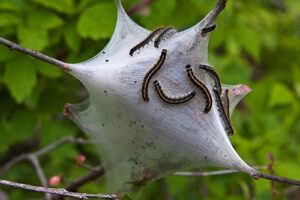Table of Contents
ToggleLast Updated on May 4, 2025
About Tent Caterpillars
The eastern tent caterpillar moth is a native North American pest, that can regularly be found throughout New Jersey. Tent caterpillar nests are a common sight on cherry, apple and crabapple trees in the late spring and early summer months. These unsightly silken webs are built in the crotches of the tree limbs and can become quite large based on the number of caterpillars on the tree. During the day you may see these nests filled with hundreds of caterpillars. Eastern tent caterpillar moth populations fluctuate from year to year with large outbreaks occurring every eight to ten years. During years with high populations the eastern tent caterpillar moth can also be found on plum, pear, maple and hawthorn trees.
The eastern tent caterpillar moth overwinters on the tree as an egg, usually in a mass of 150-400 eggs. These egg masses are covered with a shiny black material the helps protect the eggs during the winter months. Once spring arrives the larvae hatch, this is normally around the same time cherry tree buds open and the trees begin to produce leaves. As the larvae crawl, they produce a silken string which is the beginning of their nest.
What Tent Caterpillars Feed On
The caterpillars feed for 4 to 6 weeks on the foliage of the host tree and grow to approximately 2 to 2 ½ inches in length. Feeding generally occurs during the day time if temperatures allow. Most feeding will occur within 3 feet of each tent caterpillar nest, so it is common to see multiple nests per host tree. During the night, or in the rain the caterpillars will stay inside the nest for protection from the elements. As they grow so will the size of the nest. The eastern tent caterpillar moth can defoliate a tree when populations are high, and some tree species may be killed if the tree does not have enough time to grow a new set of leaves for food production and storage prior to the winter. Any level of feeding and leaf loss weakens the host tree. In home landscapes the nests can become an eyesore, especially as defoliation occurs and they become more visible.
Mature eastern tent caterpillar moths will leave the host tree and search for a suitable, protected location to spin their cocoon and pupate. It is during this wandering phase that they become a nuisance and can be a mess when found on driveways, patios and walkways. The caterpillars are no longer feeding at this time, so no further damage will be caused to surrounding trees. Once a favorable location has been found the caterpillar will spin a white or yellowish cocoon. Once inside the cocoon the caterpillar transforms into a pupa and remains in the cocoon for approximately 3 weeks. Once fully mature, the eastern tent caterpillar moth emerges from the cocoon. Adult eastern tent caterpillar moths are reddish-brown in color and have a wingspan of about one inch. Male and female eastern tent caterpillar moths mate and the female will begin to lay eggs on small branches. These eggs will hatch in the spring of the following year. We see one generation of eastern tent caterpillar moths in New Jersey per year.
If you have experienced tent caterpillar moth damage on your trees, we recommend learning more about Deep Root Fertilization to promote tree recovery.
Treatment
There are a wide range of treatment options for eastern tent caterpillar moths that range from removal to chemical control. Beneficial insects, birds and toads feed on the eastern tent caterpillar moth. Beneficial wasps parasitize eggs, larvae and pupae reducing that year’s eastern tent caterpillar moth population. Early control is essential in minimizing damage to the host tree. Pruning of small twigs and branches that contain egg masses can be done in the winter prior to the eggs hatching in the spring. Small tent caterpillar nests may be removed and destroyed in the spring. Tent caterpillar removal is best when the nest is small, prior to feeding damage. The tent caterpillar nest should be destroyed or disposed of offsite. Removing the nest from the host tree and leaving it on site will allow the caterpillars to migrate to another host tree.
The application of registered insecticides by a licensed company is also a tent caterpillar treatment option. Tent caterpillar treatments must be applied to the host tree once the tent caterpillar nests are visible. They are protected while inside the nest, so it is important the tent caterpillar treatment be applied to the branches and leaves of the host tree as well as the tent caterpillar nest. As the tent caterpillars venture outside of the nest to feed they ingest the tent caterpillar treatment and are controlled. It is important to only use a licensed pesticide applicator for the treatment of eastern tent caterpillar moths. The timing for tent caterpillar treatment is critical as the application is only effective up until the wandering phase.
Conclusion
If you have a history of eastern tent caterpillar moth activity on your property contact your tree care company to discuss tent caterpillar treatment options and timing for your area. If you are in our service area and have any questions about this pest, feel free to contact our office at 908-281-7888 or request an estimate.


